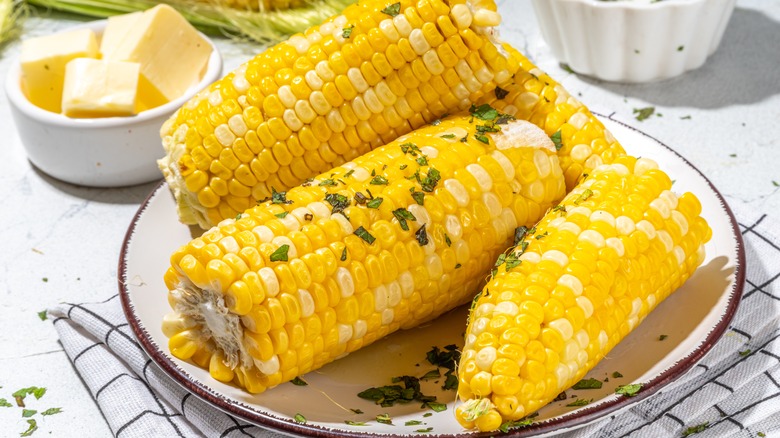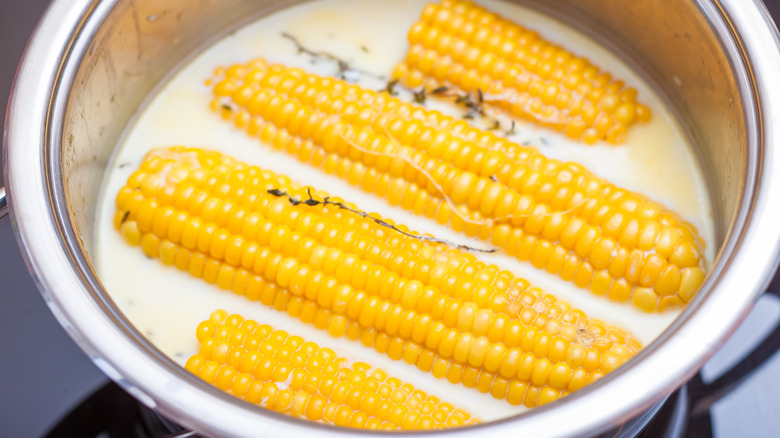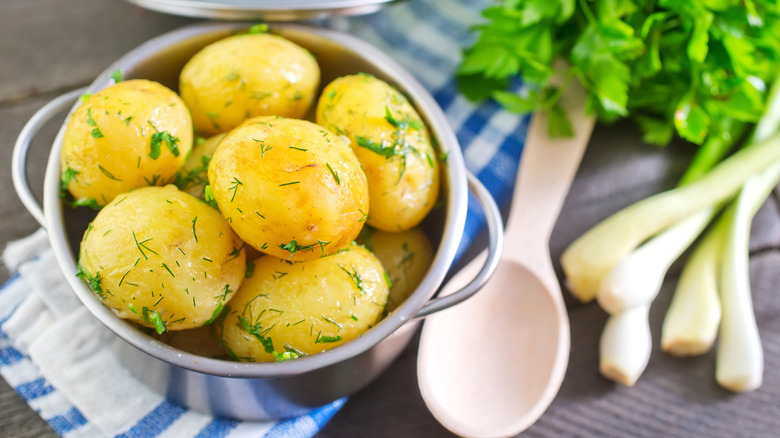Trust Us — You Should Be Boiling Corn In Butter
If you haven't tried boiling corn in a mixture of water, butter, and milk, the time has come to raise your cob game, because butter bath corn is as delicious as it sounds. This technique infuses all the buttery goodness you would normally apply on corn post-cook, except this way it's boiled straight into every kernel, making them tender and creamy while retaining that sweet pop.
A butter bath also helps you balance the flavors of the corn. While getting the freshest, sweetest ears is ideal, adding a few pinches of salt and sugar into the butter bath will turn even a less-than-perfect batch of corn soft, sweet, and luxurious. Experiment with flavoring ingredients, like spices, honey, mustard, and more, to infuse each kernel with even more goodness.
Best of all, you've probably got everything at home that's required to make butter bath corn. The proportions of butter and milk are simple to follow, and all you need is a large pot. Since you're making a rich mixture that uses a healthy amount of butter, make the most of it and boil a large batch of corn. There's no such thing as too much corn on the cob, and if there is some left over, simply remove the kernels from the cob and store them in an airtight container for up to three days in the refrigerator.
Boil corn in a mix of water, butter, and milk
To prep a luxurious buttery bath for those cobs, bring a large pot of boiling water to a simmer and add butter, salt, milk, and a pinch of sugar. Once all the ingredients are thoroughly mixed and the butter has melted, drop in the shucked ears of corn and bring the heat to medium-high.
Ensure there is enough in the pot to cover all the cobs. You can't really go too wrong with the proportions (and there's no such thing as too much butter when it comes to corn), but try to stick to about 1 cup of water, half a cup of milk and a tablespoon of butter per ear. Reduce the salt you'd otherwise add to the butter bath when using salted butter. A pinch of sugar also helps bring out the corn's natural sweetness or brighten up the flavor of off-season corn.
Expect to boil them for about 8 to 10 minutes; the exact time can vary depending on the corn used, so checking the kernels for tenderness is the best way to ensure the correct softness.
A butter bath is an easy way to buttery goodness
Butter-boiled corn is the gateway to easy and decadent buttery vegetables cooked in a similar way. While corn is a classic, you can also butter-boil potatoes, carrots, Brussels sprouts, and even broccoli and cauliflower florets. This technique results in tender, seasoned vegetables that are luxuriously buttery but not overly greasy (since most of the butter remains in the pot). The milk also enhances the vegetables' natural sweetness, and after that, it's up to you to decide what flavors you'd like to infuse into your butter-boiled veggies. You can also try butter boiling if you're attempting to make the internet viral green beans in a bag at home.
Garlic and herbs like rosemary, thyme, and sage work well with most buttery vegetables, while a bit of honey and red pepper flakes benefit butter-boiled sweet potatoes (which are different from yams). Dijon mustard added to butter-boiled corn gives acidic complexity to the creamy milk and butter notes — just remember to add aromatics and flavoring ingredients to the butter bath before adding the corn or vegetables.
You can also make butter bath corn using the sous vide method, which takes significantly longer but results in the most flavorsome corn on the cob. Add a tablespoon of butter, aromatics, and salt to the water and seal it in the sous vide bag with the ears. Whichever method you use, cooking corn in butter is the rule that'll give you consistently delicious buttery cobs.


